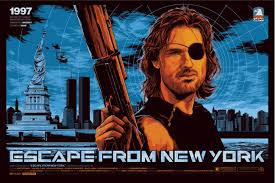Escape from New York (1981): A Movie Review

The time is a "future" of 1997. In this dystopian situation, the United States is at war with the Soviet Union --- a rather 'hot' war as opposed to the 'cold' one of historical memory.
In the United States, at least, this situation has necessitated a state of marshal law at home. For one thing, certain cities have had their entire residential and business functions completely drained, and are, therefore, used solely as prisons. The city of New York is chief among these.
The entire city of New York is a prison. There is, therefore, no need for guards internal to the city, since the entire city is blocked off entirely from free civilian life. The guards, or security is posted in command stations within binocular site of the New York City Prison.
This, of course, means that there is, therefore, no need for the prisoners to be housed in tiny "cells," and made to adhere to any sort of routine. This, again, means that, while the inmates are strictly limited to the territory of New York City, they are otherwise perfectly free to make whatever society they will.
It is into this society that the President of the United States of America, aboard Air Force One, is plunged when his plane goes down due to some mechanical failure, or something. He was on his way to deliver some important message to some conference about "blah, blah, blah..."
Friends, I say that the President's plane goes down due to "some mechanical failure or something," and "blah, blah, blah..." because the movie does a very poor job of making the audience care about anyone or anything going on in it.
Friends, it's like this: There are some directors who miss the mark when they go too far with their natural expansive tendencies. They may go too far with the gorgeous scenery. They may go too far with the number of characters who appear in the film. They may go too far with the number of big ideas that they attempt to have their film manage. They may go too far with the CGI and special effects, and all that. They may go too far with the number and intricacy of their plot lines for the film. And so on and so forth.
The writing, producing, directing team of the Wachowskis, for example, draw precisely this criticism from time to time. One might invoke their film, Jupiter Ascending, as a for instance.
However, there are other directors, who tend toward simplicity, order, and coherence, go overboard, if you will, by making their films too simplistic, orderly, and coherent. John Carpenter, in my opinion, is one of these kinds of filmmakers.
He went wrong, as I say, by taking his dominant tendency toward simplicity, order, and coherence --- and making a film so stripped down as to make it positively skeletal. I claim that this is the case with "Escape from New York."
So, what else happens in the movie?
Well, Kurt Russell plays a former, decorated Special Forces elite commando-turned-good old fashioned outlaw, who calls himself "Snake." He is conditionally released from prison to rescue the President. If Snake does so, he will be released from prison and have all of his crimes committed in the United States pardoned.
Snake makes a show of reluctance as he agrees to take on the mission. And one more thing: Snake is injected with a timed-release toxin that will kill him in four hours. In order to get that toxin deactivated and win his freedom, he must go in and get the President out before four hours (he needs to have a good five-to-ten minutes to spare, or something like that, blah, blah, blah...)
That is roughly the set up; and I did not care about any of it.
Why not?
What it comes down to is the feeling that I was watching the skeleton of a movie, rather than a fully formed flesh and blood film with a soul. You see, even if someone held a gun to my head, I could not tell you what the soul of "Escape from New York" is.
Indeed, it might as well have been adapted from a video game of the early 1980s --- Atari 2600 stuff. It wasn't, as far as I know. However, it is very easy to picture each scene's video game antecedent.
For example:
- Video Game Challenge #1: Help Snake land the infiltration plane on the appropriate New York City landmark.
- Video Game Challenge #2: Help Snake battle thugs and find the cabbie (Ernest Borgnine).
- Video Game Challenge #3: Ride with cabbie to the dwelling of "The Brain," who knows where the President is being kept.
- Video Game Challenge #4: Music legend Isaac Hayes is in this film, as "The Duke" of New York City prison. Help the Duke shoot around the captive President --- tied to a wall --- without hitting him or killing him.
- Video Game Challenge #5: Out on the streets after dark? Watch out! Here comes the "crazies," beings so far gone mentally that they only look vaguely human now. Quick. Get away. Hide somewhere! Shoot them!
- Video Game Challenge #6: Help Snake defeat a big, baldheaded, circus strongman-type wrestler.
- Video Game Challenge #7: After Snake defeats the wrestler, run around... because everybody else is running around; and find the President tied to a chair in a room.
- Video Game Challenge #8: Take the President and run away, as Isaac Hayes and his thugs chase Snake and his helpers.
- Video Game Challenge #9: Run across the bridge, that happens to be booby-trapped with bombs, without being blown up, as Isaac Hayes and his group and Snake and his group shoot at each other; also, Isaac Hayes can run people down with his car (he's driving a car; and Snake and Company are driving with the cabbie).
- Video Game Challenge #10: Get bonus points if you can, somehow, get a gun into the hands of the President, and he uses it to shoot people.
Conclusion
Blah, blah, blah... The movie just fizzles tiredly to the end.
Now, from the vantage point of 2019 (I just recently borrowed this film for free, from my local public library), it is hard to see this as having been worthy of a big screen release in 1981 or any other year prior.
This film is so stripped down, it's skeletal. This is a zombie of a movie, unconcerned with anything beyond sheer physical survival. Zombies, as you know, do not concern themselves with anything as "high falutin'" as wonder, beauty, curiosity, philosophy, or..., or... art, you know, abstract stuff like that.
This is, at best, as far as its ambition, a made-for-television movie.
Thank you for reading!








